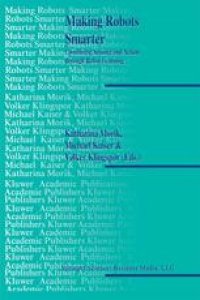
Ebook: Making Robots Smarter: Combining Sensing and Action Through Robot Learning
- Tags: Artificial Intelligence (incl. Robotics)
- Year: 1999
- Publisher: Springer US
- Edition: 1
- Language: English
- pdf
Making Robots Smarter is a book about learning robots. It treats this topic based on the idea that the integration of sensing and action is the central issue. In the first part of the book, aspects of learning in execution and control are discussed. Methods for the automatic synthesis of controllers, for active sensing, for learning to enhance assembly, and for learning sensor-based navigation are presented. Since robots are not isolated but should serve us, the second part of the book discusses learning for human-robot interaction. Methods of learning understandable concepts for assembly, monitoring, and navigation are described as well as optimizing the implementation of such understandable concepts for a robot's real-time performance.
In terms of the study of embodied intelligence, Making Robots Smarter asks how skills are acquired and where capabilities of execution and control come from. Can they be learned from examples or experience? What is the role of communication in the learning procedure? Whether we name it one way or the other, the methodological challenge is that of integrating learning capabilities into robots.
Making Robots Smarter is a book about learning robots. It treats this topic based on the idea that the integration of sensing and action is the central issue. In the first part of the book, aspects of learning in execution and control are discussed. Methods for the automatic synthesis of controllers, for active sensing, for learning to enhance assembly, and for learning sensor-based navigation are presented. Since robots are not isolated but should serve us, the second part of the book discusses learning for human-robot interaction. Methods of learning understandable concepts for assembly, monitoring, and navigation are described as well as optimizing the implementation of such understandable concepts for a robot's real-time performance.
In terms of the study of embodied intelligence, Making Robots Smarter asks how skills are acquired and where capabilities of execution and control come from. Can they be learned from examples or experience? What is the role of communication in the learning procedure? Whether we name it one way or the other, the methodological challenge is that of integrating learning capabilities into robots.
Making Robots Smarter is a book about learning robots. It treats this topic based on the idea that the integration of sensing and action is the central issue. In the first part of the book, aspects of learning in execution and control are discussed. Methods for the automatic synthesis of controllers, for active sensing, for learning to enhance assembly, and for learning sensor-based navigation are presented. Since robots are not isolated but should serve us, the second part of the book discusses learning for human-robot interaction. Methods of learning understandable concepts for assembly, monitoring, and navigation are described as well as optimizing the implementation of such understandable concepts for a robot's real-time performance.
In terms of the study of embodied intelligence, Making Robots Smarter asks how skills are acquired and where capabilities of execution and control come from. Can they be learned from examples or experience? What is the role of communication in the learning procedure? Whether we name it one way or the other, the methodological challenge is that of integrating learning capabilities into robots.
Content:
Front Matter....Pages i-xiv
Front Matter....Pages 1-1
Introduction to Skill Learning....Pages 3-16
Learning Function Approximators....Pages 17-44
Learning Sensor Assisted Assembly Operations....Pages 45-52
Learning and Re-Calibration in Flexible Assembly....Pages 53-64
Contact Estimation for Compliant Motion Control....Pages 65-84
Learning Sensor-Based Navigation....Pages 85-107
Learning to Control a Visual Sensing System....Pages 109-125
Front Matter....Pages 127-127
Learning In Human-Robot Communication....Pages 129-136
Learning To Classify....Pages 137-160
Learning a Taxonomy of Failures in Assembly....Pages 161-184
Incremental Signal to Symbol Processing....Pages 185-198
Learning Understandable Concepts for Robot Navigation....Pages 199-224
Program Optimization for Real-Time Performance....Pages 225-240
Back Matter....Pages 241-271
Making Robots Smarter is a book about learning robots. It treats this topic based on the idea that the integration of sensing and action is the central issue. In the first part of the book, aspects of learning in execution and control are discussed. Methods for the automatic synthesis of controllers, for active sensing, for learning to enhance assembly, and for learning sensor-based navigation are presented. Since robots are not isolated but should serve us, the second part of the book discusses learning for human-robot interaction. Methods of learning understandable concepts for assembly, monitoring, and navigation are described as well as optimizing the implementation of such understandable concepts for a robot's real-time performance.
In terms of the study of embodied intelligence, Making Robots Smarter asks how skills are acquired and where capabilities of execution and control come from. Can they be learned from examples or experience? What is the role of communication in the learning procedure? Whether we name it one way or the other, the methodological challenge is that of integrating learning capabilities into robots.
Content:
Front Matter....Pages i-xiv
Front Matter....Pages 1-1
Introduction to Skill Learning....Pages 3-16
Learning Function Approximators....Pages 17-44
Learning Sensor Assisted Assembly Operations....Pages 45-52
Learning and Re-Calibration in Flexible Assembly....Pages 53-64
Contact Estimation for Compliant Motion Control....Pages 65-84
Learning Sensor-Based Navigation....Pages 85-107
Learning to Control a Visual Sensing System....Pages 109-125
Front Matter....Pages 127-127
Learning In Human-Robot Communication....Pages 129-136
Learning To Classify....Pages 137-160
Learning a Taxonomy of Failures in Assembly....Pages 161-184
Incremental Signal to Symbol Processing....Pages 185-198
Learning Understandable Concepts for Robot Navigation....Pages 199-224
Program Optimization for Real-Time Performance....Pages 225-240
Back Matter....Pages 241-271
....